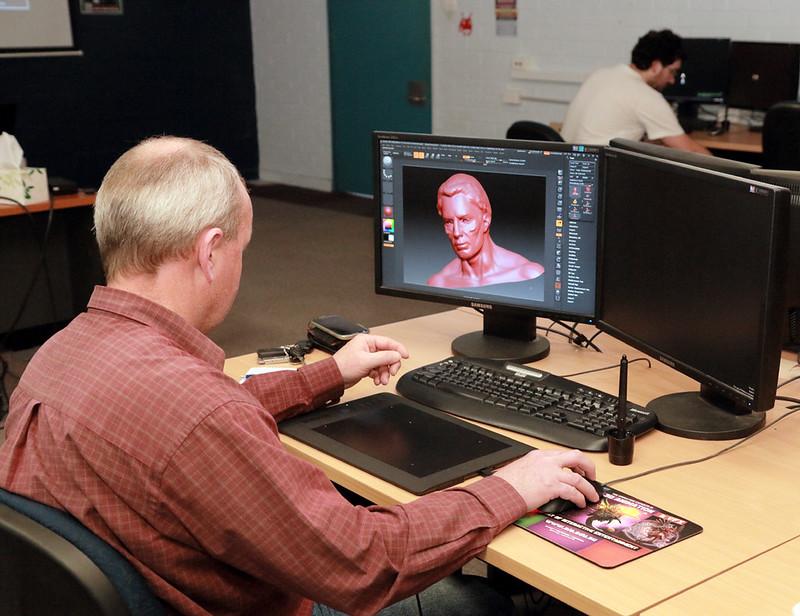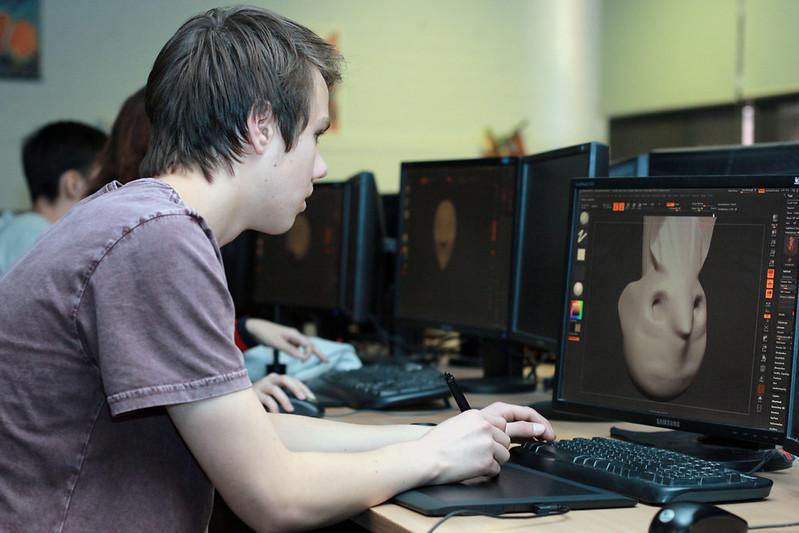As a character designer, I design animated characters for various media, most commonly, film and video games, using my artistic skills. Want to work in this field? Check out this guide below!
I will discuss an overview, a 7-step career guide, outlook, mention the necessary tools, and answer FAQs about this job. So, dive into this guide now!
Overview
Let’s look at an overview of character designers, including roles, duties, work environment, and elements, before diving into my ultimate career guide!
Who Is A Character Designer?
A character designer is a person who creates the characters’ artwork in stories, like cartoons, video games, movies, or books. They’re the artists who bring characters to life.
Imagine you’re watching a cartoon about a funny, green alien. A character designer would decide what this alien looks like (how many eyes it has, what clothes it wears, and whether it has a big smile or a serious face).
These designers are vital because they help tell the story better. For example, a scary monster in a movie needs to look terrifying, and a cute, friendly character in a children’s show should look lovable.

What Do Character Designers Do?
As a character designer, I take a story, turn it into visual characters, and ensure they fit perfectly into the story. Here’s exactly what I do:
- Read the story or script to know what the characters should look like, including their personality, roles, and how they fit in the story.
- Develop characters by deciding how they dress, how their face and body look, and how they act.
- Work with the writers and other designers to ensure the character matches the story.
- Try out character’s versions to see what works best instead of just settling on the first idea.
- Be open to feedback from clients, coworkers, and bosses. If they have suggestions to make the character better, I make changes.
- Use artistic skills to draw the character. I make sure they look like they belong in the story.
- Create sheets that show the character from all angles and in different moods. These help animators and other artists keep consistent.

Work Environment
Character designers can work in different places. Many have jobs at design or animation studios. In such cases, they work in an office setting with their team.
Regarding working time, some designers work full-time, which means they have a regular 40-hour workweek and get health insurance and job security.
Others work as freelancers. They don’t have a regular job and work on different projects when they come up. They often have more control over their hours and can work from home or other places that they like.
3 Elements Character Designer Must Know
Character designers must master the silhouette, color palette, and exaggeration elements to craft characters that resonate with audiences and communicate their traits.
1. Silhouette (lines and shapes):
You must know how to use lines and shapes to make characters look friendly, scary, or anything in between. For example, round shapes might make a character look cute, while sharp angles can make them look mean.
2. Color palette:
You must know how to pick colors to make characters look unique and to make people feel certain emotions. Like using red for passion or green for calmness.
3. Exaggeration:
Sometimes, you need to make parts of a character really big or make them do big actions. For instance, big eyes can make a character look cute, and big gestures can show they’re a hero or a villain.
How To Become A Character Designer
Now let’s walk through the seven steps to start a character design career, including how to get a relevant education and sharpen up the necessary skills!
1. Get A Relevant Degree
Getting a degree is a big help in becoming a character designer. While you don’t always need one, having a degree makes you look more qualified to employers and gives you more job options in the competitive field of character design.
Here are some degree options to start a career in this field:
- Associate degree: It is a beginner’s degree. It teaches you the basics of drawing, design, and illustration. With this, you can start in entry-level jobs or internships.
- Bachelor’s degree: In this more advanced degree program, you’ll learn more about character design and related things. Many companies like hiring people with a Bachelor’s degree for better jobs.
- Master’s degree: If you want to become a real expert, specialize, and reach high positions in character design, you can go for this degree.
A degree also helps you build a portfolio, get feedback from experienced teachers, and connect with others in the industry. These things can make it easier to find character design jobs.
2. Sharpen Up Your Skills

To become a great character designer, besides the education foundation, you need to practice drawing, be creative, talk about your ideas, work well with others, and get comfortable with computer software.
Drawing skills
Drawing is at the heart of character design. So, practice drawing regularly to get better at it by working on the body, facial expressions, and poses.
Creativity
Being creative is vital for character design. To practice this skill, cultivate your imagination by getting inspiration from nature, different cultures, or history.
Communication skill
You need to be able to explain your ideas well. I recommend practicing talking about your designs and listening to what others say. Clear communication helps you work better with others (writers, animators, etc.).
Computer software skills
In today’s world, it’s vital to know how to use computer software for designing, like Adobe Illustrator or Photoshop, which are popular in character design.
3. Apply For An Internship
After completing the degree program, you should apply for an internship because it offers:
- Valuable hands-on experience
- Mentorship
- Ahance to build your portfolio
- Professional network
Don’t know where to find internships? If you’re in college, your college probably has a career office. They can help you find internships, improve your resume, and practice for interviews.
Otherwise, you can search the internet and look for internships on job websites or at company websites. Just type “character design internship” and your location into the search bar.
Don’t be afraid to apply to lots of internships. The more you apply, the better chance you have to get one.
4. Build A Professional Portfolio
Your portfolio is like your artistic resume. If your portfolio impresses employers, they might invite you for an interview or offer you a job. So, how to build a portfolio as a character designer?
First, gather your top-notch character design pieces to show off your skills and creativity. Then, make a website where you can display your artwork. Having your own website makes it easy for employers to see your work in one place.
Your portfolio should reflect your style as a character designer. Whether you like creating cute characters or more serious ones, make sure your style stands out.
5. Take Specialized Courses Or Training

Next, you should take a specialized course or training as it provides structured learning and focused skill development. Here are some options that can help you become a skilled character designer:
- Character design workshops are short classes where you learn how to make characters. They’re a good start.
- Animation and illustration courses teach you how to make characters move and tell stories with pictures.
- Digital art and graphic design classes help you use computer programs (Adobe Illustrator, Photoshop, etc.) for character design.
- Life drawing classes show you how to draw people and animals realistically. It’s important to know anatomy for character design.
- Storytelling and narrative classes teach you how to create characters that fit into stories and are helpful for character designers in movies and games.
- Concept art and visual development courses are great for character designers in entertainment. Here, you learn to turn ideas into pictures.
When choosing a specialized course or training, think about the type of character design work you want to do and pick the one that aligns with your career aspirations.
I recommend looking for reviews or recommendations from past students to know the course quality and what you can expect.
6. Network With People In The Field

This career is not just about creating art; it’s also about connecting with people in the field by:
- Attending workshops and industry events
- Joining online groups
When you go to these places, you can meet and learn from experienced character designers, producers, and animators. It is a chance to ask for advice about your career, including:
- Which courses to take
- What skills are in demand
- How to stand out in the field
These pros might become references for your job applications if you make a good impression. They can vouch for your skills when you’re applying for jobs.
Networking also keeps you in the loop about the latest happenings in character design and animation. You can stay informed about industry changes, new software, and artistic trends.
7. Apply For A Job
At this point, you probably have enough knowledge, professional skills, and practical experience to apply for this position. But before applying, ensure your portfolio shows off your best character designs.
Besides a portfolio, your application needs to have a resume that fits the job. To create one, focus on your character design skills and any related experience with simple language.
One essential thing in this step is to research the company that you’re applying to. You need to understand what kind of characters they work on and their style. Remember to mention this in your cover letter or interview.
If they invite you for an interview, be ready to talk about your work. I recommend practicing explaining your designs and how you work with others in advance. With these tips, character design is right at your fingertips!
Essential Tools and Software

Below are popular tools and software in the industry that I often use to bring my creative visions to life:
- Adobe Photoshop and Illustrator: These are my best friends. Photoshop helps create and edit character images, while Illustrator is great for making clean, scalable illustrations.
- Blender: It helps me craft 3D characters for games and animations.
- 3D Studio Max and Maya: These are suits for my detailed 3D character models and animations.
- Mudbox and ZBrush: These are digital sculpting tools. I use them to make super-detailed 3D characters with intricate textures.
- Substance Designer: This tool helps create realistic textures for characters.
- Quixel: It offers a library of high-quality scanned materials and 3D assets.
- TVPaint: It’s for making characters move in 2D animations.
- ToonBoom Harmony: This 2D animation tool offers advanced tools for character rigging and animation.
- CelAction: It is another 2D animation tool for creating smooth and efficient character animations suitable for television and web series.
Because I work on many different projects, I am proficient in all these tools. But if you only work in a specialized area, for example, 2D or 3D, you just need to pick the one that fits your project and style.
Job Outlook

Although there is no specific job data for character designers, we can look at similar jobs to get an idea of the job outlook. Specifically, from 2022 to 2032:
- Jobs for visual effects artists & animators can grow by 8%
- Jobs for craft & fine artists can grow by 4%
- Jobs for graphic designers can grow by 3%.
These figures show that there are job opportunities for character designers. The entertainment industry is expanding, with more demand for animated content in movies, TV, games, and online platforms.
FAQs
What Are Some Related Careers Of Character Design?
Related careers to character design include animation, illustration, graphic design, concept art, and special effects artistry.
How Much Do Character Designers Earn Per Year?
Character designers typically earn between $42,000 and $69,000 per year, with an average of around $54,000.
Is Character Designer A Promising Career For The Future?
Yes, character design is promising, especially with the growing demand for animated content in entertainment and advertising. As a result, it offers opportunities for career growth.
Wrap Up
This guide has shown you seven steps to start your career in character design. You now know how to get an education and build your skills and portfolio to apply for jobs.
The future for character designers looks bright because there’s a growing need for animated content. So, you can have a fulfilling career by learning, practicing, and being passionate about telling stories visually!
